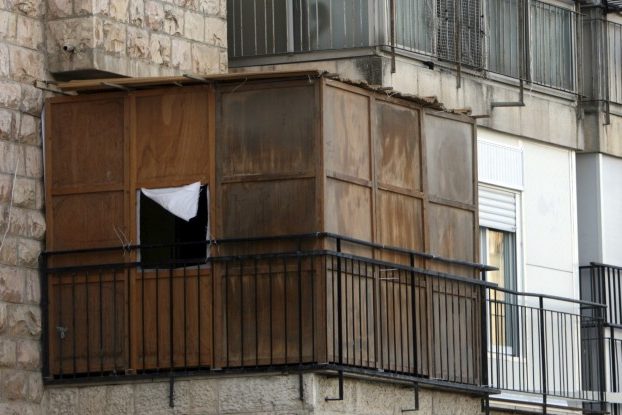The Average-Wind Principle:
As mentioned above, any material is valid for wall construction, with the only requirement being that the structure be capable of withstanding an “average” wind, that blows in that location (the requirements for a Sukkah on the top of Mt. Washington, where the highest recorded wind velocity (231 MPH) was measured, would probably be different from the requirements in an area of gentle wind).
A Sukkot Fairy Tale:
There is a story about three little pigs (pardon the expression) who decided that they were old enough to make their own way in the world, and so left their home. Each of them built a “house” (it would be difficult to say that the pigs made Sukkot) of different materials. Little Pig Number 1 built his out of straw, Little Pig Number 2 built his out of wood, and Little Pig Number 3 built his out of bricks.
A hungry wolf, not a friend of the little pigs, came to visit each. He attempted to blow their houses down (let’s assume that he started with the force of an “average” wind, although in reality (which is very important in a fairy tale)) it was probably stronger.
The wolf succeeded immediately in blowing down the house of Little Pig Number 1, whose fate is unknown, except for the fact that the smell of pork chops (again, pardon the expression) was noticed in the neighborhood where Number 1’s house had been.
When he went to the house of Little Pig Number 2, the wolf’s initial attempts to blow the house down were unsuccessful. However, when he raised the intensity of his blowing to that of a strong wind, the house eventually collapsed, and Little Pig Number 2 met a similar fate as had Number 1.
However, when he went to Little Pig Number 3’s house, which had been made of strong brick, the wolf huffed and he puffed, and he puffed and he huffed, until he was blowing as hard as a moderate-force hurricane, but the house withstood all his efforts.
Thus, we see that had the little pigs in fact been interested in Sukkah-building, Little Pig Number 1 would have failed miserably, even as his house did when put to the test by the wolf. Little Pig Number 2 probably had made an adequate Sukkah because it protected him against the initial blowing efforts by the wolf although, much to his ultimate displeasure, it could not protect him when the wolf raised the intensity of his blowing above the level of an “average” wind. Little Pig Number 3, although safe from the attack of the wolf, could probably have used his house as a bomb-shelter, and thus had gone way beyond the “temporary”-ness required of a Sukkah.
Walls Which Don’t Quite Make It:
If, say, the canvas walls of one’s Sukkah were improperly designed, or done in this manner as an example of modern “Sukkah” architecture, but in any case don’t quite reach the floor, what is the “shiur,” or measure for validity, that is required?
According to the Sages, if the walls are within 3 “tefachim” of the ground, the Sukkah is acceptable. In centimeters, this measure is approximately 24 – 29 cm., about one foot. The explanation of this measurement is that it corresponds to the height under which a goat could run in and out, “adding” to the calm and peacefulness of the Holiday meals, and “rest periods.”
What about the Overall Size of the “Sukkah”?
The overall size of any object, or thing, is given by the combination of the height and the area. For example, a city skyscraper and a flagpole might have the same height. But the fact that they have different areas makes the skyscraper much bigger than the flagpole!
The minimum area of a Sukkah is defined in the Talmud to be seven-by-seven “tefachim,” or about two feet by two feet. When we combine this with the minimum height, ten “tefachim, or about one yard, we find that the minimum overall size of a “Sukkah” is just about large enough to accommodate the “head and most of the body of a man, and the “mini” – table from which the man eats,” to use the definition of the Talmud. This corresponds to the size of a small refrigerator, or the space needed to accommodate a short, seated adult.
There is no maximum for the overall size of a Sukkah. It could be so large, made so by vast lengths and widths, to accommodate the entire Jewish People, or the population of the world. The Midrash speaks of the Sukkah made for the righteous in the World-to-Come as being made from the skin of the Leviathan, the giant sea-creature. To use a much smaller, but perhaps more familiar example, consider Godzilla.
